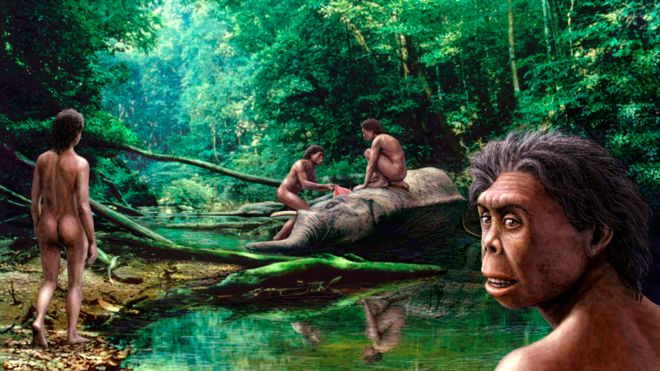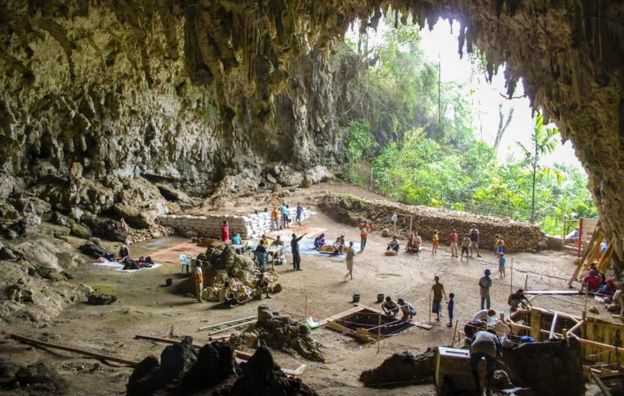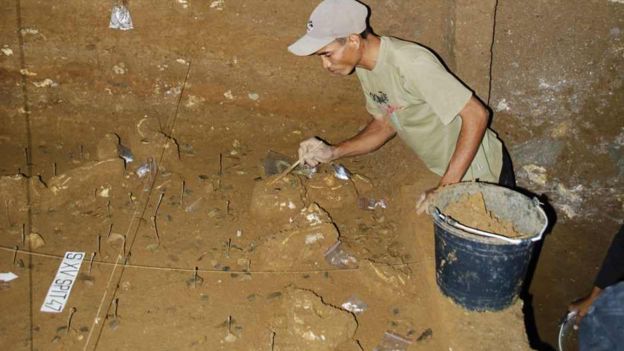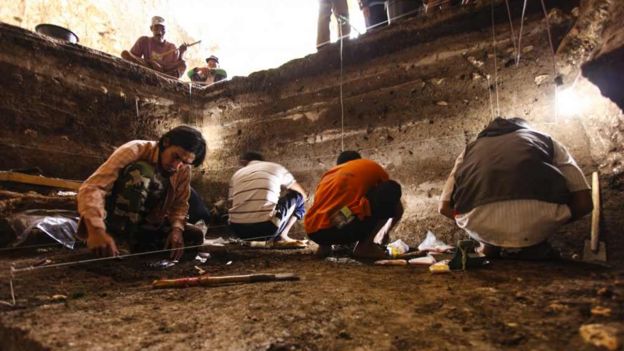- 8 minutes ago
- Science & Environment
 SPL
SPL
The diminutive human species nicknamed "the Hobbit" is older than previously recognised, scientists now say.
The discovery of Homo floresiensis in 2003 caused a sensation because it seemed the creature could have been alive in the quite recent past.
But a new analysis indicates the little hominin probably went extinct at least 50,000 years ago - not the 12,000 years ago initially thought to be the case.
Researchers report their revised assessment in the journal Nature.
Prof Bert Roberts, from the University of Wollongong, Australia, says the revised dating actually resolves what had always been a head-scratcher: how it was possible for floresiensis to survive for 30,000 to 40,000 years after modern humans are believed to have passed through Indonesia.
"Well, it now seems we weren't living alongside this little species for very long, if at all. And once again it smells of modern humans having a role in the downfall of yet another pieces," he told BBC News.
"Every time modern humans arrived somewhere new, it tended to be bad news for the endemic fauna. Things would go pear-shaped pretty quickly."
 Liang Bua Team
Liang Bua Team
This does not mean we necessarily killed the Hobbits; it may just have been that we made life miserable for them.
Modern humans could have outcompeted the little people for the best food resources and land, for example.
The Liang Bua cave on the island of Flores where the Hobbit fossils were unearthed continues to be investigated.
The intervening years have seen researchers dig down through new areas, to get a better picture of how the sediments are structured.
It now transpires that the first floresiensis specimens were lodged just below an unconformity - a missing, eroded layer of material.
The absence of this sediment made the context of the 2003 find appear younger than it actually was.
Various dating technologies have subsequently been applied to the contents of the cave to help build a new time sequence.
This points to the skeletal remains of floresiensis being between about 100,000 and 60,000 years old.
"But then we have some stone tools that were 50,000 years old and these were very likely made by Hobbits," explained Prof Roberts.
"We say 'very likely', not because they were small stone tools able to fit in their hands, but because they were made from a volcanic rock called silicified tuff, which they seemed to prefer.
"When modern humans came through that region, we used stone tools made of chert, for example.
"So, 50,000 years ago is when the Hobbits disappear, as far as we can determine. But then we haven't excavated the whole cave yet."
 Liang Bua Team
Liang Bua Team
One of the key implications of the new dating is that it fells one of the early counter-theories about the origin of the Hobbits - that they might not have been a separate species but merely a diseased form of modern human.
But if the Hobbits were living on Flores 100,000 years ago, this view is no longer tenable: no modern humans have been recorded in south-east Asia so far back in time.
Prof Chris Stringer, from the Natural History Museum in London, UK, is an expert on ancient humans.
He agrees that the new research helps straighten out the story of the Hobbits, and makes it much more likely that we were indeed involved in their extinction somehow.
"The other fascinating and tricky thing to think about is the possibility of interbreeding. We know modern humans interbred with Neanderthals and Denisovans (other archaic human species), so could they have got together withfloresiensis? Are there people on Earth today who have a little bit of Hobbit DNA in them? You couldn't rule it out."
 Liang Bua Team
Liang Bua Team
Jonathan.Amos-INTERNET@bbc.co.uk and follow me on Twitter:@BBCAmos

No comments:
Post a Comment